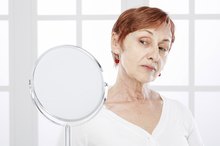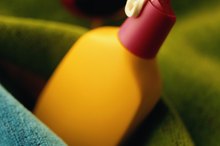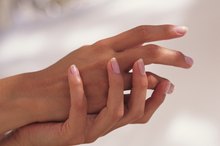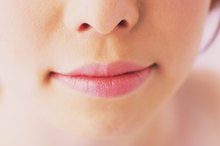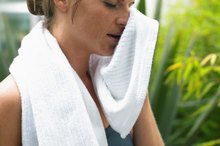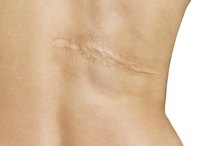What does fact checked mean?
At Healthfully, we strive to deliver objective content that is accurate and up-to-date. Our team periodically reviews articles in order to ensure content quality. The sources cited below consist of evidence from peer-reviewed journals, prominent medical organizations, academic associations, and government data.
The information contained on this site is for informational purposes only, and should not be used as a substitute for the advice of a professional health care provider. Please check with the appropriate physician regarding health questions and concerns. Although we strive to deliver accurate and up-to-date information, no guarantee to that effect is made.
Damaged Thin Skin
Thin skin can be dangerous, in that it tears, bruises and cuts easily. It does not usually indicate a serious underlying problem but a trip to the doctors could help ease your mind and find you the right solution you need. There could be a few reasons for damaged thin skin, but thankfully there are also treatments.
Identification
Your skin is your body’s largest organ, averaging 8 lbs. It is made up of three layers which help to waterproof, insulate and guard the body against extreme temperatures, sunlight and chemicals, according to the National Geographic website. The innermost layer of your skin is the subcutis, which is the insulating layer that acts as a cushion for your insides. The middle layer of skin is called the dermis, which gives your skin its strength and elasticity. The outer layer of skin is called the epidermis, which consists of mainly the protein keratin.
- Your skin is your body’s largest organ, averaging 8 lbs.
- The middle layer of skin is called the dermis, which gives your skin its strength and elasticity.
Causes
What Are the Causes of Thinning Facial Skin?
Learn More
Thin skin damages easily. Aging is a major cause of thin skin 1. As you get older, your skin becomes thinner, paler and translucent, according to the University of Maryland Medical Center 2. Other causes of thin skin include the sun, genetics, medical conditions or side effects of medication 1. Too much sun breaks down the collagen in the skin and over time, your skin loses elasticity. Oral or topical corticosteroids can weaken your skin, making it vulnerable to thinning and damage. A medical condition, dermatologists call actinic purpura, solar purpura or Bateman’s purpura, is bruising on the back of the hands and arms.
- Aging is a major cause of thin skin 1.
- Oral or topical corticosteroids can weaken your skin, making it vulnerable to thinning and damage.
Effects
Due to aging, thin skin loses its ability to retain moisture and changes in the connective tissues reduce your skin’s elasticity and strength. Underneath your skin, the blood vessels become more visible and fragile which contributes to your thin skin damaging more easily. Actinic purpura is mostly seen in older adults due to years of sun exposure and differs from normal bruises in that it does not hurt, the bruising lasts longer and wasn’t caused by much of a bump, according to the American Osteopathic College of Dermatology. Blood thinners, aspirin, alcohol or steroids can make the condition worse.
- Due to aging, thin skin loses its ability to retain moisture and changes in the connective tissues reduce your skin’s elasticity and strength.
Treatment
How to Treat Red Veins on the Face
Learn More
There are certainly no treatments for aging but there are ways to help prevent thin skin as well as avoiding the risk factors that contribute to aging. Sun exposure causes the most skin changes and damage, so using sun block, wearing protective clothing and keeping out of the sun will go a long way in preventing thinning skin and damage. A good moisturizing lotion can help keep your skin from drying out, becoming thin and tearing. Treating actinic purpura can include a daily application of alpha-hydroxy acid cream or Retin-A prescription cream to help increase the thickness of your skin, according to the American Osteopathic College of Dermatology. Aesthetically, there are cosmetics that can be used to camouflage the bruising.
- There are certainly no treatments for aging but there are ways to help prevent thin skin as well as avoiding the risk factors that contribute to aging.
- Sun exposure causes the most skin changes and damage, so using sun block, wearing protective clothing and keeping out of the sun will go a long way in preventing thinning skin and damage.
Considerations
Dehydration increases the risk of skin injury and nutritional deficiencies can cause skin lesions, according to the University of Maryland Medical Center website 2. Eating a good diet with adequate nutrients can help keep your skin healthy. Drinking plenty of water will also keep your skin well hydrated.
Related Articles
References
- Mayo Clinic: Thin Skin: What Causes It?
- University of Maryland Medical Center: Aging Changes in Skin
- Kanitakis J. Anatomy, histology and immunohistochemistry of normal human skin. Eur J Dermatol. 2002 Jul-Aug;12(4):390-9.
- Habif TP. Clinical Dermatology E-Book. 5th ed. Elsevier Health Sciences; 2009.
- Dutton J, Gayre G, Proia A. Diagnostic Atlas of Common Eyelid Diseases. New York: Taylor & Francis Ltd.; 2007:1. doi:10.3109/9781420016321
- Alberts B, Johnson A, Lewis J, Raff M, Roberts K, Walter P. Molecular Biology of the Cell, 4th ed. New York: Garland Science; 2002.
- Kakasheva-Mazhenkovska L, Milenkova L, Gjokik G, Janevska V. Variations of the histomorphological characteristics of human skin of different body regions in subjects of different age. Prilozi. 2011;32(2):119-28.
- Sandby-Møller J, Poulsen T, Wulf HC. Epidermal thickness at different body sites: relationship to age, gender, pigmentation, blood content, skin type and smoking habits. Acta Derm Venereol. 2003;83(6):410-3. doi:10.1080/00015550310015419
- Rahrovan S, Fanian F, Mehryan P, Humbert P, Firooz A. Male versus female skin: What dermatologists and cosmeticians should know. Int J Womens Dermatol. 2018 Jun 22;4(3):122-130. doi:10.1016/j.ijwd.2018.03.002
Writer Bio
Nicole Adams is an accomplished writer, publishing in print and online. She has submitted hundreds of articles for websites, including CBS Local and Education.com. Adams earned a Bachelor of Science in psychology with concentrated studies in health and nutrition, and animal behavior and nutrition. She loves to cook and volunteers in animal rescue.
